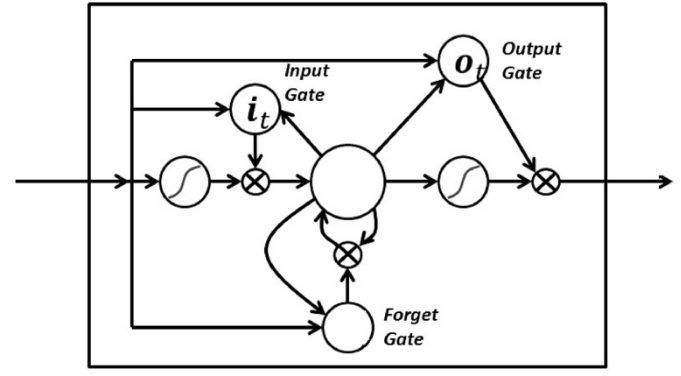Recurrent Neural Network with Long Short-Term Memory
Author
March 18, 2019
What is a Neuron?
In Biological term, Neurons is the unit of the nervous system which is responsible for the flow of message in the form of electrical impulse in the human brain. So, Neuron is responsible for Human intelligence. But, in Today’s scenario, it is used in Artificial Intelligence as well. Recurrent Neural Network (RNN) is a class of artificial neural network in which connections between the neurons form a directed graph, or in simpler words, having a self-loop in the hidden layers. This helps RNNs to utilize the previous state of the hidden neurons to learn the current state. Along with the current input, RNNs utilize the information they have learned previously. Among all the neural networks, they are the only ones with internal memory. A usual RNN has a short-term memory. Because of their internal memory, RNN is able to remember things.
How Recurrent Neural Network work?
RNN is a preferred algorithm for sequential data like time series, speech, text, financial data, audio, video, weather, and much more because they can easily form an understanding and identify trends of a sequence and its context, compared to other algorithms. But, What is the Sequential data? Basically, it is the ordered data, where related things follow each other. Examples are financial data or the DNA sequence. The most popular type of sequential data is perhaps Time series data, which is just a series of data points that are listed in time order.
In an RNN, the information cycles through a loop. When it makes a decision, it takes into consideration the current input and also what it has learned from the inputs it received previously. Recurrent Neural Networks add the immediate past to the present.
As you can see in the figure, Previous State, s(t-1) acts as an input for Present State, s(t). Therefore, State, s(t) has 2 inputs x(t) and its previous State, s(t-1). Further, s(t) is propagated to s(t+1). Therefore, a Recurrent Neural Network has two inputs, the present, and the recent past. This is important because the sequence of data contains crucial information about what is coming next, that is what RNN can memorize things and use them for the future.
Recurrent Neural Network with Long Short-Term Memory
There are many issues arise with RNN like it has very small memory to store and Vanishing Gradient is the major problem in which the values of a gradient(partial derivative with respect to its inputs/or it is a measure how much the output of a function changes if you change the inputs a little bit) are too small and the model stops learning or takes way too long because of that. This problem is solved through the concept of LSTM by Sepp Hochreiter and Juergen Schmidhuber. Long Short-Term Memory (LSTM) basically extends the memory of RNN. In LSTM, there are 3 gates:
- Input Gate: Determine whether or not to let new input in.
- Forget Gate: Delete the information which is not important or to let it impact the output at the current time step.
- Output Gate: Gives the output.
These 3 Gates are responsible to decide that information is important or can be eliminated. Hence, Increase the storage.

Vanishing gradient is solved through LSTM because it keeps the gradients steep enough so that it not Vanishes and therefore the training relatively short with high accuracy.
Contact Mirketa to leverage our Elixir platform for solving your problems using the right artificial intelligence approach.
Pranshu Goyal, Director of Products at Mirekta, states: “We envision DSM to be used by every small to a medium-sized organization dealing with bad data and want to get rid of duplicates easily with no cost. We have faced issues dealing with duplicates in our organization. That inspired us to make a solution that is not only simple to use but can be used widely to make the organization’s data clean to make them more efficient and productive. We want DSM to be a solution for every organization looking for duplicate management capability better than the Salesforce out-of-the-box solution with no additional cost.”
Recent Posts
-
 Salesforce API Testing – The Modern QA Approach for Reliable Integrations05 Jan 2026 Blog
Salesforce API Testing – The Modern QA Approach for Reliable Integrations05 Jan 2026 Blog -
 Transforming SMB Sales with Salesforce Commerce Cloud12 Nov 2025 Blog
Transforming SMB Sales with Salesforce Commerce Cloud12 Nov 2025 Blog -
 Generative AI Testing tools03 Nov 2025 Blog
Generative AI Testing tools03 Nov 2025 Blog -
 Mirketa Unveils Next-Gen AI Solutions to Redefine the Future of Work Across Industries29 Jul 2025 Press Release
Mirketa Unveils Next-Gen AI Solutions to Redefine the Future of Work Across Industries29 Jul 2025 Press Release -
 Salesforce Implementation School Universities Higher Education23 Jul 2025 Blog
Salesforce Implementation School Universities Higher Education23 Jul 2025 Blog -
 Salesforce Health Cloud Implementation Partner: A Complete Guide23 Jul 2025 Blog
Salesforce Health Cloud Implementation Partner: A Complete Guide23 Jul 2025 Blog -
 XML Parsing: Using MINIDOM Vs Element Tree (etree) in Python02 Jul 2025 Blog
XML Parsing: Using MINIDOM Vs Element Tree (etree) in Python02 Jul 2025 Blog -
 A step by step Guide to create Salesforce web-to-lead form30 Jun 2025 Blog
A step by step Guide to create Salesforce web-to-lead form30 Jun 2025 Blog -
 How AI is Transforming User Experience Design in 202526 Jun 2025 Blog
How AI is Transforming User Experience Design in 202526 Jun 2025 Blog -
 How a Salesforce NPSP Consultant Can Elevate Nonprofit Impact25 Jun 2025 Blog
How a Salesforce NPSP Consultant Can Elevate Nonprofit Impact25 Jun 2025 Blog -
 Salesforce Load and Performance Testing: Essentials, Importance & Execution23 Jun 2025 Blog
Salesforce Load and Performance Testing: Essentials, Importance & Execution23 Jun 2025 Blog -
 Salesforce Website Integration Boost Leads, Automation & Customer Experience11 Jun 2025 Blog
Salesforce Website Integration Boost Leads, Automation & Customer Experience11 Jun 2025 Blog -
 Driving Results in Manufacturing with Salesforce Manufacturing Cloud11 Jun 2025 Blog
Driving Results in Manufacturing with Salesforce Manufacturing Cloud11 Jun 2025 Blog -
 Accelerating Growth with NetSuite SuiteCommerce02 Jun 2025 Blog
Accelerating Growth with NetSuite SuiteCommerce02 Jun 2025 Blog -
 Salesforce Service Cloud Services streamlining operations29 May 2025 Blog
Salesforce Service Cloud Services streamlining operations29 May 2025 Blog -
 AI for Nonprofits: Mirketa & Exec Precision Webinar27 May 2025 Press Release
AI for Nonprofits: Mirketa & Exec Precision Webinar27 May 2025 Press Release -
 AI for Nonprofits: Use Cases, Tools & Implementation Strategies20 May 2025 Webinar
AI for Nonprofits: Use Cases, Tools & Implementation Strategies20 May 2025 Webinar -
 Javascript Frameworks for Salesforce Lightning Design System18 May 2025 Blog
Javascript Frameworks for Salesforce Lightning Design System18 May 2025 Blog -
 Building a Smart Campus with Salesforce Student Information System: A Road to Smarter Education16 May 2025 Blog
Building a Smart Campus with Salesforce Student Information System: A Road to Smarter Education16 May 2025 Blog -
 Salesforce Nonprofit Cloud: Benefits & Consultant Role15 May 2025 Blog
Salesforce Nonprofit Cloud: Benefits & Consultant Role15 May 2025 Blog




























